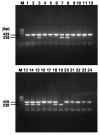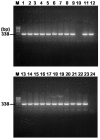Spotted fever group and typhus group rickettsioses in humans, South Korea
- PMID: 15752441
- PMCID: PMC3320442
- DOI: 10.3201/eid1102.040603
Spotted fever group and typhus group rickettsioses in humans, South Korea
Abstract
The presence of the nucleic acid of the spotted fever group (SPG) and typhus group (TG) rickettsiae was investigated in 200 serum specimens seropositive for SFG rickettsiae by multiplex-nested polymerase chain reaction with primers derived from the rickettsial outer membrane protein B gene. The DNA of SFG, TG, or both rickettsiae was amplified in the 24 serum specimens, and sequence analysis showed Rickettsia conorii, R. japonica, and R. felis in the specimens. R. conorii and R. typhi were found in 7 serum specimens, which indicated the possibility of dual infection in these patients. These findings suggest that several kinds of rickettsial diseases, including boutonneuse fever, rickettsialpox, R. felis infection, and Japanese spotted fever, as well as scrub typhus and murine typhus, are occurring in Korea.
Figures




Comment in
-
Rickettsioses in South Korea, materials and methods.Emerg Infect Dis. 2006 Mar;12(3):531. doi: 10.3201/eid1203.050334. Emerg Infect Dis. 2006. PMID: 16710987 Free PMC article. No abstract available.
-
Rickettsioses in South Korea, data analysis.Emerg Infect Dis. 2006 Mar;12(3):531-2. doi: 10.3201/eid1203.050957. Emerg Infect Dis. 2006. PMID: 16710988 Free PMC article. No abstract available.
Similar articles
-
Evaluation of PCR-based assay for diagnosis of spotted fever group rickettsiosis in human serum samples.Clin Diagn Lab Immunol. 2005 Jun;12(6):759-63. doi: 10.1128/CDLI.12.6.759-763.2005. Clin Diagn Lab Immunol. 2005. PMID: 15939751 Free PMC article.
-
Molecular detection of spotted fever group rickettsiae in Amblyomma variegatum ticks from Benin.Ticks Tick Borne Dis. 2016 Jul;7(5):828-833. doi: 10.1016/j.ttbdis.2016.03.016. Epub 2016 Apr 9. Ticks Tick Borne Dis. 2016. PMID: 27150592
-
The rickettsial outer-membrane protein A and B genes of Rickettsia australis, the most divergent rickettsia of the spotted fever group.Int J Syst Evol Microbiol. 2000 Sep;50 Pt 5:1775-1779. doi: 10.1099/00207713-50-5-1775. Int J Syst Evol Microbiol. 2000. PMID: 11034486
-
Rickettsiae and rickettsial diseases in Croatia: Implications for travel medicine.Travel Med Infect Dis. 2016 Sep-Oct;14(5):436-443. doi: 10.1016/j.tmaid.2016.06.010. Epub 2016 Jul 9. Travel Med Infect Dis. 2016. PMID: 27404664 Review.
-
Rickettsioses of the spotted fever group around the world.J Dermatol. 1989 Jun;16(3):169-77. doi: 10.1111/j.1346-8138.1989.tb01244.x. J Dermatol. 1989. PMID: 2677080 Review.
Cited by
-
Molecular detection of Rickettsia spp. in ticks and fleas collected from rescued hedgehogs (Erinaceus europaeus) in Portugal.Exp Appl Acarol. 2021 Mar;83(3):449-460. doi: 10.1007/s10493-021-00600-y. Epub 2021 Mar 2. Exp Appl Acarol. 2021. PMID: 33655451
-
Rickettsia rickettsii and Rickettsia typhi in hospitalized children diagnosed with Pediatric Multisystemic Inflammatory Syndrome in Merida, Yucatan.Braz J Infect Dis. 2024 Jan-Feb;28(1):103707. doi: 10.1016/j.bjid.2023.103707. Epub 2023 Dec 6. Braz J Infect Dis. 2024. PMID: 38070540 Free PMC article.
-
Molecular screening for tick-borne bacteria and hematozoa in Ixodes cf. boliviensis and Ixodes tapirus (Ixodida: Ixodidae) from western highlands of Panama.Curr Res Parasitol Vector Borne Dis. 2021 Jun 3;1:100034. doi: 10.1016/j.crpvbd.2021.100034. eCollection 2021. Curr Res Parasitol Vector Borne Dis. 2021. PMID: 35284894 Free PMC article.
-
Distribution of Rickettsia spp. in Ticks from Northwestern and Southwestern Provinces, Republic of Korea.Korean J Parasitol. 2019 Apr;57(2):161-166. doi: 10.3347/kjp.2019.57.2.161. Epub 2019 Apr 30. Korean J Parasitol. 2019. PMID: 31104408 Free PMC article.
-
Pathogenic Rickettsia, Anaplasma, and Ehrlichia in Rhipicephalus microplus ticks collected from cattle and laboratory hatched tick larvae.PLoS Negl Trop Dis. 2023 Aug 30;17(8):e0011546. doi: 10.1371/journal.pntd.0011546. eCollection 2023 Aug. PLoS Negl Trop Dis. 2023. PMID: 37647577 Free PMC article.
References
-
- Choi MS, Park SK, Chang WJ, Huh MS, Kim HR, Han TH, et al. A seroepidemiological survey on the scrub typhus in Korea, 1994. J Korean Soc Microbiol. 1994;30:593–602.
-
- Kim YW, Cho MK, Min CH, Yoon CS. Isolation and characterization of Rickettsia typhi from patients in Korea. J Korean Soc Microbiol. 1988;23:265–75.
-
- Song JW, Baek LJ, Lee YJ, Song KJ, Han SH. Seroepidemiologic analysis of acute rebrile illness from Korea in 1996. J Korean Soc Virol. 1998;28:377–82.
Publication types
MeSH terms
Substances
LinkOut - more resources
Full Text Sources
Miscellaneous
